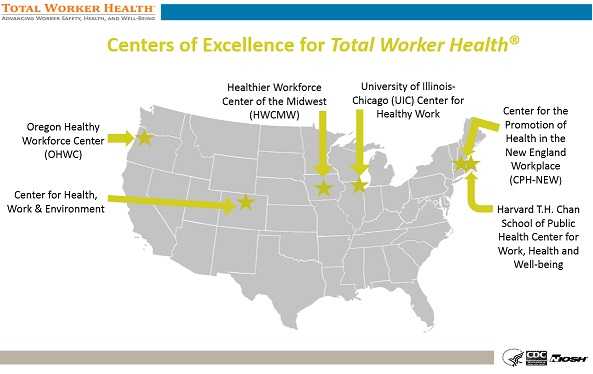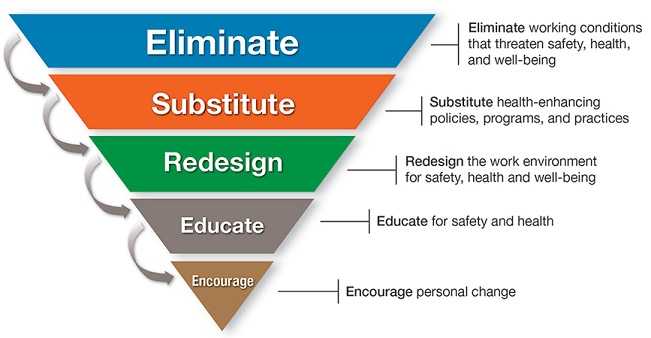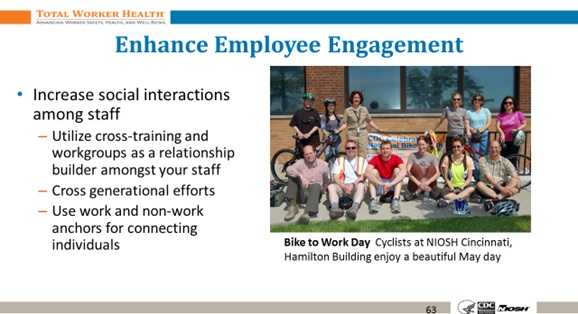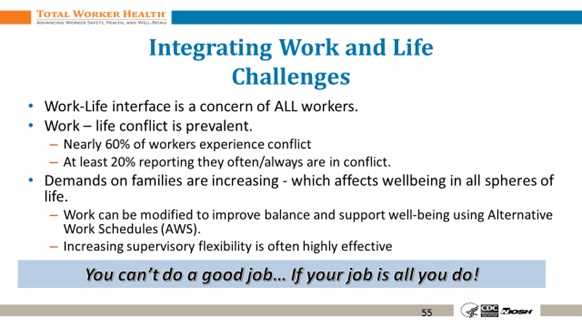Total Worker Health in Action!

In this issue:
- Managers’ Buzz
- Total Worker Health Exclusive
- Updates from the NIOSH Office for Total Worker Health
- Updates from the NIOSH National Center for Productive Aging and Work
- Spotlight on NIOSH Fundamentals of Total Worker Health Approaches
- Updates from the NIOSH Centers of Excellence for Total Worker Health
- New Publications and Resources
- Conferences, Webinars, and Trainings
Volume 5 Number 4 December 2016
Managers’ Buzz
Anita L. Schill, PhD, MA, MPH, and L. Casey Chosewood, MD, MPH

Season’s Greetings! As we enjoy this holiday season with friends and family, we are reminded of the gift of a safe and healthful work environment. Because we’re committed to providing practical guidance and resources to help organizations better implement TWH in their workplaces, we’re excited to give you Fundamentals of Total Worker Health® Approaches: Essential Elements for Advancing Worker Safety, Health and Well-being. This new workbook brings a fresh perspective on high-quality workplace policies, programs, and practices that can create and sustain safer work and healthier workers. It’s ideal for folks ready to get started in their own workplaces. Learn more about the just-released document in the Total Worker Health Exclusive.

We are thrilled to announce two additions to the family of NIOSH Centers of Excellence for Total Worker Health®! NIOSH will now fund six Centers of Excellence to further advance the overall safety, health, and well-being of the diverse population of workers in our nation. The Centers will accomplish this through innovative and multidisciplinary research, intervention development, outreach and education, and evaluation activities.

The two new Centers are:
- University of Illinois-Chicago, Center for Healthy Work
- University of Colorado, Center for Health, Work & Environment.
The four existing Centers successfully competed for funding renewal. These Centers are:
- Harvard T.H. Chan School of Public Health Center for Work, Health, & Well-being,
- Center for the Promotion of Health in the New England Workplace,
- Healthier Workforce Center of the Midwest,
- Oregon Healthy Workforce Center.
Please join us in welcoming our new Centers of Excellence and in our congratulations to all the Centers!
NIOSH works hard to bring the principles of total worker health to its own workforce through the HealthiestNIOSH program. It helps us keep our own workers safe and healthy. This issue’s Promising Practices highlights a Healthier Supervision training, offered NIOSH-wide to help supervisors create more flexible and supportive work environments for the well-being of all who work at NIOSH.
Finally, we invite you to follow the latest TWH news, events, and more by finding us on Twitter (@NIOSH_TWH), on the NIOSH Total Worker Health LinkedIn Group, or by email at twh@cdc.gov.
Total Worker Health Exclusive
Fundamentals of Total Worker Health® Approaches: Essential Elements for Advancing Worker Safety, Health and Well-being
The Office for Total Worker Health’s latest practice-based document titled Fundamentals of Total Worker Health Approaches: Essential Elements for Advancing Worker Safety, Health and Well-being is now available. Focused on the five Defining Elements of TWH, Fundamentals of TWH Approaches outlines key components of a TWH approach in any organization. The workbook can help your organization identify your starting point with TWH policies, programs, and practices and guide you in outlining steps for doing more with TWH. Fundamentals of TWH Approaches captures the “how?” and “why?” of TWH and presents them in a user-friendly format. Filled with examples and worksheets, this workbook will help your organization get started with TWH.
The excerpt below represents the guidance information in the new Fundamentals of TWH Approaches workbook that illustrates prioritizing safety in a TWH approach:

Hierarchy of Controls Applied to NIOSH Total Worker Health
The Hierarchy of Controls Applied to NIOSH Total Worker Health®provides a conceptual model for prioritizing efforts to advance worker safety, health, and well-being. As in the traditional Hierarchy of Controls, controls and strategies are presented in descending order of anticipated effectiveness and protectiveness as suggested by the cascading arrows. The Hierarchy of Controls Applied to NIOSH Total Worker Health expands the traditional hierarchy from occupational safety and health to include controls and strategies that more broadly advance worker well-being. The Hierarchy of Controls Applied to NIOSH Total Worker Health is not meant to replace the traditional Hierarchy of Controls, but rather is a companion to this important occupational safety and health model. The Hierarchy of Controls Applied to NIOSH Total Worker Health serves to illustrate how Total Worker Health approaches emphasize organizational-level interventions to protect workers’ safety, health, and well-being. To apply this model:
- Begin by eliminating workplace conditions that cause or contribute to worker illness and injury, or otherwise negatively impact well-being. This includes factors related to supervision throughout the management chain.
- Second, replace unsafe, unhealthy working conditions or practices with safer, health-enhancing policies, programs, and management practices that improve the culture of safety and health in the workplace.
- Next, redesign the work environment, where needed, for safety, health, and well-being. Remove impediments to well-being, enhance employer-sponsored benefits, and provide flexible work schedules.
- Then, provide safety and health education and resources to enhance individual knowledge for all workers.
- Lastly, encourage personal change for improvements to health, safety, and well-being. Assist workers with individual risks and challenges; provide support for healthier choice-making.
Fundamentals of Total Worker Health Approaches: Essential Elements for Advancing Worker Safety, Health and Well-being is now available for download online. Take advantage of the worksheets found within and consider which TWH issues may need to be addressed in your workplace. For more information on the Hierarchy of Controls Applied to NIOSH Total Worker Health and how it fits with the traditional Hierarchy of Controls, visit Let’s Get Started on the TWH website.
Updates from the NIOSH Office for Total Worker Health
Recently the NIOSH TWH program teamed up with the NIOSH Work Organization and Stress-Related Disorders Research Program and the NIOSH Economics Research Program to launch a new collaboration for the Institute – the Healthy Work Design and Well-being research cross-sector. The new cross-sector will fine-tune NIOSH efforts to design work, work environments, and management practices that promote worker safety, health, and well-being and hopes to inspire researchers to help answer some vital questions.
- How can we better design jobs to reduce worker stress, illness, and injury?
- What economic drivers are influencing job design, worker safety, and health interventions?
- What preventive interventions offer the most impact for the least cost?
- How can work be crafted for greater health opportunities and organizational sustainability?
- What are the critical links between work and well-being and how do we influence them?
The group will help coordinate intramural and extramural research in this critical and challenging area. For more information on all NIOSH sectors, and the related National Occupational Research Agenda, of which this cross-sector and others are a part, visit https://www.cdc.gov/niosh/nora/default.html.
Updates from the NIOSH National Center for Productive Aging and Work (NCPAW)
More than a thousand people registered for the September webinar brought to you by the National Center for Productive Aging and Work (NCPAW), in collaboration with TWH. Did you get to attend? If not, it’s not too late to listen to the archived version. Titled, Productive Aging and Work: Theory, Health Data, and Practical Solutions, the webinar featured Dr. John Howard (NIOSH), Dr. Jim Grosch (NCPAW), Dr. Sue Dong (CPWR), and Mr. Steven Hecker (University of Washington and University of Oregon). Listeners gained firsthand insight into key attributes of productive aging and unpacked recent data on how safety and health outcomes vary across age groups, focusing on construction workers. Audience members also discovered the lessons learned from an action-oriented educational program that helps organizations create workplaces and policies supportive of workers throughout the life span. A recorded version is now available online as part of the TWH Webinar series: https://www.cdc.gov/niosh/TWH/webinar.html. Continuing education is available for the archived recording. Log on today!
Promising Practices for Total Worker Health
Working Toward Healthier Supervision at NIOSH
Constance Franklin, MPA, NIOSH Office for Total Worker Health
At NIOSH, protecting and promoting the safety, health, and well-being of diverse worker populations around the globe is a critical part of our work. But if we are really serious about this work, we strongly feel that we must apply the principles that we recommend to other organizations within our own Institute. Importantly, NIOSH workers get the opportunity to regularly provide feedback about their work environment and overall experiences through an annual survey given in all Federal workplaces. This showed that NIOSH employees wanted to see improvements in the way team leaders, managers, and supervisors fulfill their duties. A growing body of research shows that a worker’s direct-line supervisor has significant impact on an employee’s safety, morale, work experiences and performance, and even their overall health—both on and off the job.
In response, NIOSH’s internal TWH-focused program, HealthiestNIOSH, created a customized Healthier Supervision training for all workers in supervisory roles at NIOSH. The webinar-based, 90-minute training is a direct response to feedback captured through the annual Employee Viewpoint Survey conducted by the U.S. government Office of Personnel Management.
Healthier Supervision training covers a variety of areas for team leaders and supervisors. The training sought to increase the awareness and skillset in areas the survey identified as challenging, including:

Slide from the Healthier Supervision training focusing on enhancing employee engagement through social interactions among workers.
- Strategies for Work-life integration
- Healthier performance management skills
- Managing a diverse workforce
- Assisting workers with disability, chronic illness
- Optimizing flexibility
- Improving the environment for increasing employee engagement
- Improving communication skills
- Better ways to use rewards and recognition
The NIOSH Focus on Safe, Healthy Workers
NIOSH’s Director, Dr. John Howard, encouraged supervisors to participate in the new training, which met a part of the annual mandatory training for all supervisors. “NIOSH is committed to optimizing the safety, health, and well-being of our workforce and to making our work environment as healthy and supportive as it can be for all members of our NIOSH family…part of our individual responsibility to this effort is to continue to invest time in improving our skills as team leaders, supervisors, or managers,” said Dr. Howard. To date, over 60% of NIOSH team leaders, managers, and supervisors have taken the Healthier Supervision training.
Quick Take-Aways from the Healthier Supervision Training

Slide from the Healthier Supervision training encouraging supervisors to be flexible with regard to work-life balance.
At the conclusion of the training, NIOSH supervisors were reminded that quality leadership starts with attention to important growth and developmental issues within their own lives. They were charged with the following suggestions:
- Get to know yourself better, identify your strengths and play them up while working on your weaker skills
- Actively communicate every day with your colleagues and teams
- Work on transparency; share as much as you can as often as you can
- Set clear expectations of your team members, check in often, and be willing to reset
- Intervene early when problems or team member challenges or issues arise
- Recognize and reward your team members every day
- Attend to work-life-family issues, both your own and your team members’
- Learn new things; enhance your own leadership skills regularly and support your team in continuous learning and development
- Get help when you need it from colleagues or experts
HealthiestNIOSH encourages you to “Be the supervisor you would want to have!”
For more information regarding this and other safety, health, and well-being activities at NIOSH, email HealthiestNIOSH@cdc.gov.
Editors’ Note: Learn more about family-supportive supervisors research and training by exploring the Safety & Health Improvement Program, Work, Family & Health Network publications, Family-Supportive and Safety-Supportive Supervisor Behavior Training in Corrections Personnel, and Intervening for Work Stress: Work-life Stress and Total Worker Health Approaches.
*Quarterly, we feature new Promising Practices for Total Worker Health, which are examples of how employers across the country and from a wide range of industries are taking steps to effectively integrate workplace policies, programs, and practices that protect workers’ safety and health and advance their overall well-being. If your organization is proactively exploring opportunities to accomplish these goals by targeting the conditions of work, please email us at twh@cdc.gov. Your employer’s practices could be featured as a Promising Practice for Total Worker Health!
Updates from the NIOSH Centers of Excellence for Total Worker Health
Center for Health, Work & Environment
The Center for Health, Work & Environment is based at the Colorado School of Public Health at CU Anschutz. The Center builds on the successful Health Links initiative, which is now reaching hundreds of Colorado businesses in its mission to bring best practices for worksite well-being and safety from conception to practical use.
Total Worker Health is the concept that the workplace is itself a medium within which overall health interventions should take place, expanding the current norm in which businesses focus efforts on safety. Keeping safe on the job remains a priority, but Total Worker Health also recognizes that workplace health can be addressed. The Center will focus on particular Colorado and regional concerns in small- and medium size businesses including stress, work-related injuries and fatalities, aging workers and the needs of workers with chronic illnesses.
The Center will work with business and worker groups to implement TWH programs. Businesses will be able to launch health programs and gain practical information and tools to do it in an effective, sustainable way. The new Center will, in turn, learn from small businesses on how to build on their successes.
“This center is using a business approach – not an academic one,” Lee Newman, MD, Director of the Center for Health, Work & Environment. “It’s taking a more holistic approach to worker health and worker safety and, in turn productivity.” To learn more about the Center for Health, Work & Environment, please visit the Center’s website.
The Center for the Promotion of Health in the New England Workplace (CPH-NEW)
Congratulations to CPH-NEW External Advisory Committee member Marcy Goldstein-Gelb, who was just named Co-Executive Director for National Coalition for Occupation Safety and Health. “Marcy has been an extremely effective advocate for worker safety in Massachusetts, as well as a valued partner in CPH-NEW research and outreach activities,” noted Laura Punnett, CPH-NEW PI and Co-Director.“National COSH has made an excellent choice in naming her to this position; her talents will be put to good use in advancing health and safety nation-wide.”
CPH-NEW recently co-sponsored a conference for 90 faculty, students, and public health leaders. “Environment, Epigenetics and Cancer: How to Cultivate the Connections” was held on October 24 at University of Connecticut Storrs.
CPH-NEW’s updated website, www.uml.edu/cphnew, features new research projects, tools, and resources available to implement TWH in the workplace.
Harvard T.H. Chan School of Public Health Center for Work, Health, and Well-Being
The Harvard T.H. Chan School of Public Health Center for Work, Health, and Well-being is collaborating with Professor Brian Oldenburg from the WorkHealth Improvement Network, Melbourne School of Population and Global Health, at the University of Melbourne. Drs. Oldenburg, Glorian Sorensen, and Jack Dennerlein will be submitting joint abstracts for the 2017 Work, Stress, and Health Conference, among other activities.
The center is offering an executive and continuing professional education course for practitioners on using TWH approaches. Registration for the 2017 course is open. Glorian Sorensen, PhD, and Center collaborator Nico Pronk, PhD, are directing the annual Harvard Chan School’s Executive and Continuing Professional Education (ECPE) for their course entitled “Work, Health, and Well-being: Frameworks, Evidence, and Applications.” Course attendees represent frontline organizations from business, health care, universities, and governments spanning the globe. The course aims to provide practitioners with the research and tools necessary to implement integrated approaches to worker safety, health, and well-being.
Healthier Workforce Center of the Midwest (HWCMW)
Employers in the Midwest struggling with workplace health and safety issues now have a stronger ally in their efforts to promote a safer and healthier workforce. Workers in Iowa and neighboring states experience more work-related injuries and illnesses than in other parts of the U.S., according to the U.S. Centers for Disease Control and Prevention. The region also has higher rates of unhealthy behaviors such as heavy alcohol consumption and obesity than other areas of the country, with high rates of occupational fatalities. Recognizing the critical needs in the region, particularly among small employers, the University of Iowa is pleased to announce the expansion and launch of the Healthier Workforce Center of the Midwest, in partnership with Washington University in St. Louis and the Nebraska Safety Council, to provide increased attention to these issues.
The National Institute of Occupational Safety and Health has funded the Healthier Workforce Center at the University of Iowa since 2006 to address TWH. Center Director Diane Rohlman, PhD, believes this expanded effort will better serve regional needs. “Our partnerships in Nebraska, Missouri, and Kansas will help us leverage even more practical and research expertise to help businesses succeed and to maximize the safety and health of our workers,” said Rohlman. Find more information by visiting the Center’s website.
Oregon Healthy Workforce Center (OHWC)
OHWC has just announced its Toolkit Kiosk! Designed as a one-stop source for all OHWC research products, the kiosk houses a combination of evidence-informed quick tools for Total Worker Health and comprehensive evidence-based toolkits from research projects, including SHIP, PUSH, and Be Super.
OHWC recently hosted a Partners’ Luncheon to honor partners in existing projects at the Center and to welcome new partners. In other news, OHWC Director Kent Anger has joined the advisory committee of the Pacific Northwest Agricultural Safety and Health Center, located at the University of Washington. To learn more about the OHWC, visit the center’s YouTube channel.
University of Illinois-Chicago Center for Healthy Work
The newly funded University of Illinois at Chicago (UIC) Center for Healthy Work seeks to turn unhealthy work into healthy work by focusing on the health impacts of precarious jobs. A growing number of working adults are employed in these temporary, contract, and involuntary part-time jobs which may offer no control over dangerous working conditions, low wages, few or no benefits, long hours, no opportunities for advancement, and no assurance of long-term employment. Research by economists Katz and Krueger indicate that the percentage of workers employed in these “alternative work arrangements” increased from 10% of the workforce in 2005 to 16% in 2015.
Shifting the social norm of work—that everyone deserves and has the right to a healthy job—requires a wide range of actions at multiple social and economic levels. The Center will focus first on scanning and mapping the nature and structure of precarious jobs in Chicago, building on long-term collaborations with organizations, professionals, and community partners. Additionally, the Center will partner with local, regional, and national organizations to craft and implement policies and programs aimed at turning unhealthy into healthy work.
The Center for Healthy Work under Director Lisa Brosseau, ScD, MS hopes to join and empower communities undertaking long-term protection efforts at the local, state, regional, and national levels to make healthy work the norm rather than the exception.
News from our TWH Affiliates and Partners
Welcome four new NIOSH TWH Affiliates!
AgriSafe
NIOSH TWH Affiliate
We are pleased to announce AgriSafe as a new NIOSH TWH Affiliate. AgriSafe is a national organization representing health and safety professionals who strive to reduce health disparities found among the agricultural community.Educational services are also provided for agricultural businesses and those involved directly in agricultural production.AgriSafe believes that many agricultural injuries, diseases, and fatalities can be prevented through the delivery of appropriate agricultural occupational health services. AgriSafe services include continuing education via workshops and webinars, training for college agricultural students, clinical resources, and information on cutting-edge developments in agricultural health & safety.
Industrial Minerals Association–North America
NIOSH TWH Affiliate
The Industrial Minerals Association–North America (IMA-NA) is the representative voice of companies which extract and process a vital and beneficial group of raw materials known as industrial minerals. Industrial minerals are the ingredients for many of the products used in everyday life, and these companies and the people they employ are proud of their industry and the socially responsible methods they use to deliver such beneficial resources. IMA-NA aims to keep workers and laborers safe on site, with the understanding that safety goes in tandem with physical and mental health.
Interdisciplinary Center for Healthy Workplaces
NIOSH TWH Affiliate
The Interdisciplinary Center for Healthy Workplaces, based at University of California, Berkeley, has set its mission to become a global resource for businesses, professional firms, labor unions, employees, and the public in understanding how to create healthy workplaces, as well as a locus of innovation in the design and implementation of work and workplace changes based on integrated science. The Center’s goal is to identify and integrate key scientific findings associated with employee health and well-being across disciplines in order to understand how to build a new organizational template that will promote employee health and well-being.
University at Buffalo
NIOSH TWH Affiliate
The University at Buffalo, including the Human Factors and Ergonomics Group in the Industrial and Systems Engineering Department, is actively engaged in research and educational activities focused on worker well-being. Recent research priorities have emphasized job design, work organization, and organizational interventions. In addition, students engage in coursework emphasizing the role of integrating human factors and worker health into the broader context of designing effective work systems.
New Publications and Resources
Fundamentals of Total Worker Health® Approaches: Essential Elements for Advancing Worker Safety, Health and Well-being
This practice-based document from the Total Worker Health program is designed to help organizations implement TWH approaches in the workplace. Practitioners, workers, and employers alike can find beneficial tools and resources inside.
Tobacco in the Workplace
NIOSH’s Respiratory Health Division has just released a new web page focused on Tobacco in the Workplace. The new topic page offers information about tobacco use in the workplace and strategies that organizations can utilize to go tobacco free.
Oregon Healthy Workforce Center Toolkit Kiosk
The OHWC Toolkit Kiosk, a one-stop source for complete products from interventions along with guides on how to implement them, is now available.
6 New Publications from Centers of Excellence for Total Worker Health
- Integrating worksite health protection and health promotion: A conceptual model for intervention and research. This paper from researchers at the Harvard T.H. Chan School of Public Health Center for Work, Health, and Well-Being presents a conceptual model to guide research and inform the design, implementation, and evaluation of integrated Total Worker Health approaches. The model is based on the principle that the conditions of work may determine outcomes important to organizations (such as absence and turnover), as well as individual safety and health outcomes and behaviors.
- Work characteristics as predictors of correctional supervisors’ health outcomes. Researchers at CPH-NEW examined work factors that may predict health behaviors and health outcomes such as obesity in a group of high-stress workers. Correctional supervisors surveyed showed higher rates of obesity and other health conditions compared to the general adult U.S. population.
- The application of salutogenesis to correctional officers in corrections settings. In this book chapter, researchers at CPH-NEW discuss methods focused on health-enhancing approaches for correctional officers.
- Overtime, shift work, poor sleep and the effects on obesity: a public health problem. In this editorial, CPH-NEW researchers discuss the link between sleep and long work hours and elevated risk of obesity and chronic disease.
- Safety and health support for home care workers: the COMPASS randomized controlled trial.In this article, OHWC researchers discuss how the COMmunity of Practice And Safety Support (COMPASS) intervention impacted both safety and health factors for home care workers.
- Addressing young workers’ needs: the Promoting U through Safety and Health (PUSH) trial outcomes.OHWC researchers tested a Total Worker Health web-based training with younger workers and assessed knowledge gains and safety and health behavior change as a result.
- The hidden costs of informal work: lack of social protection and subjective well-being in Colombia.Researchers at OHWC found that contingent workers in Colombia had lower subjective well-being than workers in standard work arrangements.
- Stress linked to workers’ comp claims. This article cites research from the Center for Health, Work & Environment about the relationship between workplace accidents and stress. View the original research article here.
CPH-NEW Emerging Topics: News and Views
- CPH-News and Views Issue #47: Commuting and work—What contributes to employees’ risky commuting safety behaviors and what can be done about it?
- CPH-News and Views Issue #48: Total Hearing Health—Protecting your hearing at work and at home
Conferences, Webinars, and Trainings
December
12th—Dr. L. Casey Chosewood presented “Connecting Cumulative Risk and Total Worker Health” at the Society for Risk Analysis Annual Meeting in San Diego, California.
13th—Ms. Chia-Chia Chang, MPH, MBA, and Ms. Kellie Pierson, MS, presented “The ‘What’ and ‘How’ of Total Worker Health” at the North Dakota Worksite Wellness and Workforce Safety & Insurance events in Bismarck, ND.
February
1st—Ms. Chia-Chia Chang will present “Integrated Live Well/Work Well Program Design: Dartmouth Hitchcock Case Study” at the Health Benefits Conference & Expo in Clearwater Beach, Florida.
3rd—Ms. Chia-Chia Chang will present on Total Worker Health at the University of Michigan Friday Public Health Seminar Series with Dr. Lisa Brosseau.
6th to 8th—Drs. Glorian Sorensen and Nico Pronk will direct the annual Harvard Chan School’s Executive and Continuing Professional Education (ECPE) program by presenting their course entitled “Work, Health, and Well-being: Frameworks, Evidence, and Applications.” Registration is currently open.
2017 and 2018
Save the Date for Work, Stress, and Health 2017: June 7–10, 2017
The 12th International Conference on Occupational Stress and Health, “Work, Stress, and Health 2017: Contemporary Challenges and Opportunities,” will be held at the Hotel Minneapolis in Minnesota from June 7 to 10, 2017. Details can be found on the conference website: http://www.apa.org/wsh. Don’t forget to mark your calendars.
Save the Date for Expanding Research Partnerships: State of the Science Conference: June 21–22, 2017
NIOSH, in partnership with the University of Colorado, Denver, is pleased to announce a 2017 conference, Expanding Research Partnerships: State of the Science, in Denver, Colorado. The conference goals are to: enhance and expand intramural and extramural partnership in occupational safety and health research and launch the 3rd decade of the National Occupational Research Agenda (NORA). The conference content is not limited to any specific field of work, and all scientific disciplines are invited to submit abstracts. There will also be a plenary session devoted to early career scientists.
Save the Date for Understanding Small Enterprises: October 25–27, 2017
The Center for Health, Work & Environment at the Colorado School of Public Health, in collaboration with NIOSH,is pleased to host the fourth international Understanding Small Enterprise (USE) Conference in Denver, Colorado, on October 25–27, 2017. There are many ways small enterprises benefit from creating safer and healthier workplaces. That’s why small businesses, researchers, students, and public health professionals from around the globe will come together at USE 2017 to understand theunique needs of small businesses and share strategies for cultivating healthy work environments. Abstract submissions are due January 15, 2017.
Save the Date for the 2nd International Symposium to Advance Total Worker Health: May 8–11, 2018
In spring 2018, the only NIOSH-sponsored conference dedicated solely to advancing Total Worker Health research and practice returns to the campus of the National Institutes of Health in Bethesda, Maryland. Esteemed presenters from nonprofits, government agencies, academic institutions, and the private sector will share the latest perspectives, research findings, and practical applications of Total Worker Health. This triennial conference is not to be missed!
Contributors
Editorial Board
- L. Casey Chosewood, MD, MPH, Executive Editor
- Anita L. Schill, PhD, MA, MPH, Executive Editor
- CDR Heidi Hudson, MPH, Editor-in-Chief
- Reid Richards, Managing Editor
- Seleen Collins, Copy Editor
- Steve Leonard, NIOSH Web Publisher
Please send your comments and suggestions to us at twh@cdc.gov.
This newsletter is published quarterly via email by the National Institute for Occupational Safety and Health Total Worker Health® Program to inform members of the public health community as well as interested members of the general public of program-related news, new publications, and updates on existing activities and initiatives.
Get Email Updates
To sign up to receive the TWH Newsletter, enter your email address:
- Page last reviewed: December 20, 2016
- Page last updated: December 20, 2016
- Content source:
- National Institute for Occupational Safety and Health Office of the Director
TOTAL WORKER HEALTH ® is a registered trademark of the US Department of Health and Human Services


 ShareCompartir
ShareCompartir